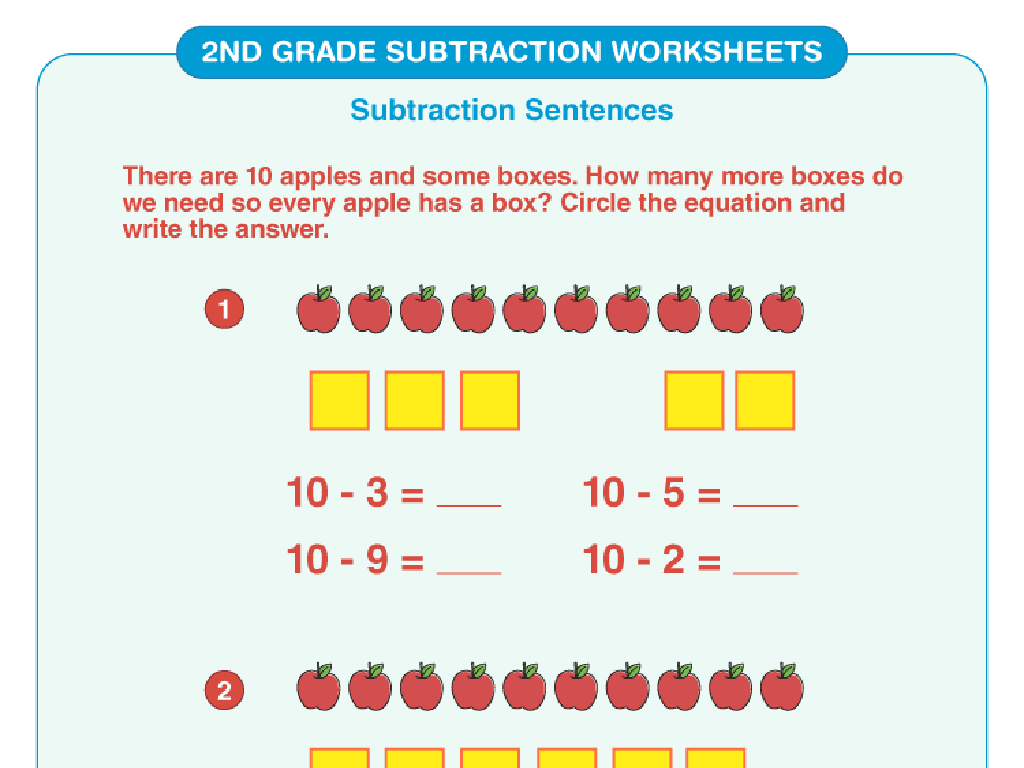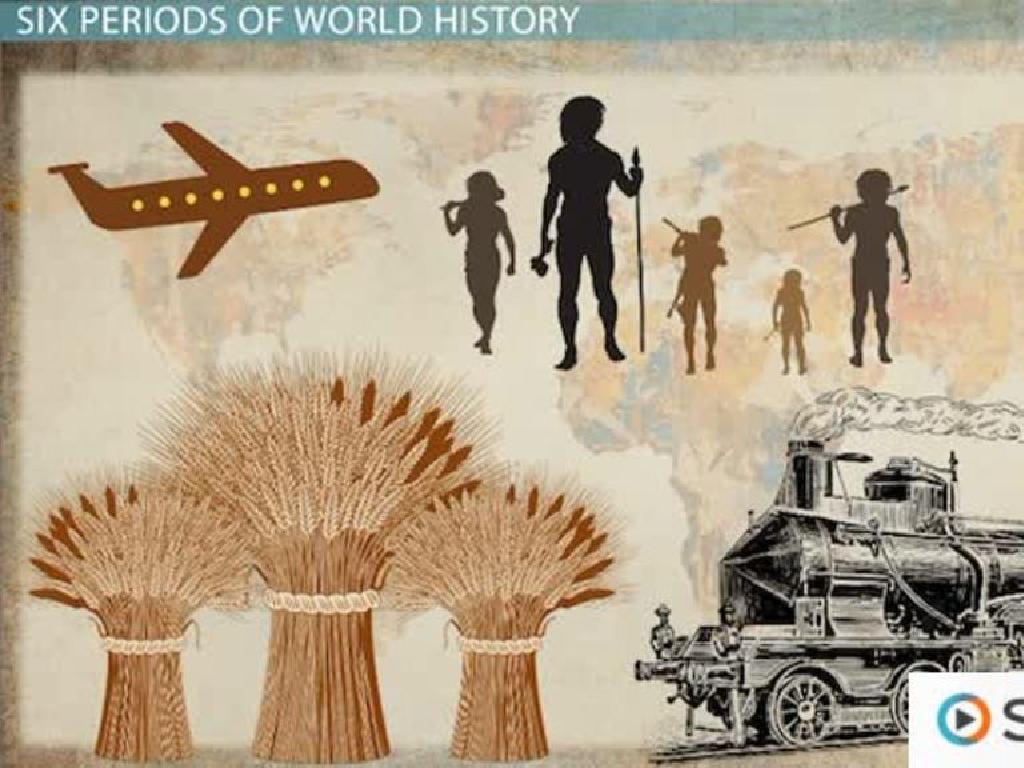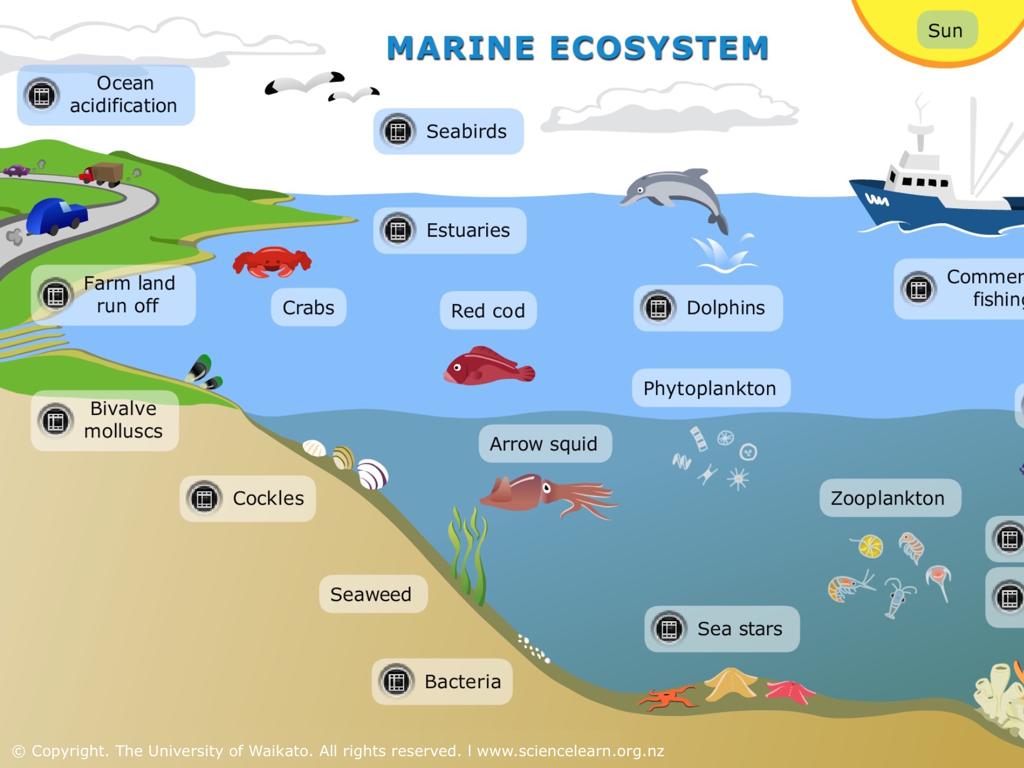Identify Thirds
Subject: Math
Grade: Second grade
Topic: Fractions
Please LOG IN to download the presentation. Access is available to registered users only.
View More Content
Understanding Thirds in Fractions
– What are thirds in fractions?
– A third means one out of three equal parts
– Parts of a whole explained
– Imagine cutting a pizza into 3 equal slices, each slice is a third
– Thirds in everyday life
– Like sharing 3 apples with 2 friends, each gets a third
– Practice finding thirds
|
Introduce the concept of thirds by explaining that it represents one part of something that is divided into three equal parts. Use tangible examples like slicing a pizza or sharing apples to illustrate the idea of thirds. Discuss how fractions are used in everyday situations, such as dividing food or sharing toys, to make the concept relatable. Encourage students to think of other examples where they might encounter thirds in their daily lives. Provide practice opportunities with objects that can be divided into thirds to reinforce the concept. The goal is to ensure students can identify and understand thirds as a fundamental aspect of fractions.
Understanding Fractions: Identifying Thirds
– Fractions show parts of a whole
– Numerator and denominator explained
– Top number (numerator) is the part we have, bottom number (denominator) is the total parts
– Everyday examples of fractions
– Pizza slices, sharing 3 apples, 1/3 of an hour
– Focusing on ‘thirds’ in fractions
– A whole divided into 3 equal parts, each part is one third
|
This slide introduces the concept of fractions to second graders by explaining that fractions represent parts of a whole. Emphasize that the numerator, the top number, indicates how many parts we’re looking at, while the denominator, the bottom number, shows how many equal parts the whole is divided into. Use relatable examples like dividing a pizza into slices or sharing apples to illustrate fractions in daily life. Then, focus on the concept of ‘thirds’, explaining that when something is divided into three equal parts, each part is called ‘one third’. Encourage students to think of other examples of ‘thirds’ and discuss why understanding fractions is important.
Meet the Thirds Family
– Thirds have a denominator of 3
– It’s like cutting a pizza into 3 slices
– Each third is 1 of 3 equal parts
– Imagine sharing a cookie with 2 friends
– Visualizing 1/3, 2/3, and 3/3
– Pictures help us see the parts
– Understanding whole with thirds
– 3/3 means the whole thing, like 3 slices make a whole pizza
|
This slide introduces the concept of thirds to second-grade students. Begin by explaining that in fractions, the denominator (the number below the line) tells us into how many equal parts something is divided. In the case of thirds, the denominator is always 3, indicating that something is divided into three equal parts. Use visual aids like images of a pizza cut into three slices or a cookie divided among three friends to illustrate 1/3, 2/3, and 3/3. Emphasize that when all three parts are combined (3/3), it represents a whole item. Encourage students to think of other examples of thirds in their daily lives and to draw or bring items that can be divided into thirds for the next class.
Identifying Thirds in Shapes
– Finding thirds in shapes
– Look at different shapes divided into parts
– Count equal parts for thirds
– Make sure there are 3 equal parts
– Color one of three parts
– Use colors to highlight a single part
– Understanding 1/3
|
This slide is aimed at helping second-grade students understand the concept of thirds by visually and interactively working with different shapes. Start by showing shapes divided into equal parts and guide the students to count and ensure there are three parts, which is essential for identifying thirds. Encourage them to color one of the three equal parts to represent 1/3, reinforcing the concept that one third means one out of three equal parts. Use simple shapes like circles, rectangles, and squares to make it easier for the students to visualize and comprehend. In the next class, have students bring in their colored shapes to discuss and reinforce their understanding of thirds.
Exploring Thirds in Fractions
– Thirds in everyday life
– Think pizza, watermelon, pie cut into 3 pieces
– Thirds mean three equal parts
– Each part is one out of three equal sections
– Class activity with real examples
– We’ll divide objects into thirds together
– Understanding and identifying thirds
|
This slide is aimed at helping second-grade students recognize and understand the concept of thirds in the context of fractions. Begin by discussing familiar items that are often divided into thirds, such as pizza slices, watermelon, and pie, to illustrate the concept in a relatable way. Emphasize that when something is divided into thirds, it is split into three equal parts. Engage the class with an interactive activity where students can participate in dividing different objects into thirds, reinforcing the idea that each third is one of three equal sections of the whole. Use real-life objects or visual aids for this activity to make the concept more tangible. Encourage students to ask questions and share their thoughts on what they’ve learned about thirds.
Let’s Practice Identifying Thirds!
– Practice thirds with shapes
– Look at different shapes and find a way to divide them into three equal parts.
– Group activity: cut and divide
– Work together to cut out shapes and then divide them into thirds.
– Share your thirds
– Show your divided shapes and explain how you made the thirds.
|
This slide is for a hands-on group activity to help students understand the concept of thirds by dividing various shapes into three equal parts. Provide students with scissors, paper, and examples of shapes. Guide them to work in groups to cut out the shapes and then fold or mark them to show thirds. Encourage them to discuss their methods and reasoning with their group members. After the activity, each group will share their shapes with the class, explaining how they identified and made the thirds. This will reinforce their understanding and allow them to see different ways thirds can be represented. As a teacher, circulate the room to assist and ask guiding questions to ensure all students are engaged and comprehending the concept of thirds.
Class Activity: Fraction Fun with Thirds!
– Create thirds using paper and scissors
– Cut a paper into 3 equal parts to make thirds
– Decorate each third uniquely
– Use colors, stickers, or drawings to decorate
– Combine thirds for a class project
– We’ll put all the thirds together on a board
|
This activity is designed to help second-grade students understand the concept of thirds in a fun and interactive way. Provide each student with a sheet of paper and guide them on how to fold and cut it into three equal parts, emphasizing the idea that each part is one third of the whole. Encourage creativity as they decorate their thirds with various art supplies. Once completed, gather all the decorated thirds and assemble them into a collaborative class art project. This visual and hands-on approach aids in solidifying their understanding of fractions, specifically thirds, and how they make up a whole when combined. It also fosters teamwork and a sense of community in the classroom.
Review: Understanding Thirds
– Recap on thirds concept
– Thirds mean dividing something into 3 equal parts
– Find thirds around us
– Look around to spot objects divided into thirds
– Q&A session
– Summarize today’s lesson
– Let’s remember the key points about thirds
|
This slide aims to consolidate the students’ understanding of the concept of thirds by reviewing what was covered in the lesson. Start by asking the students to explain what thirds are, reinforcing the idea that it involves dividing something into three equal parts. Then, engage the students in a practical activity by having them look around the classroom to identify objects that can be divided into thirds, such as a clock or a pie chart. Proceed to a Q&A session where students can ask questions and clarify their doubts. Conclude by summarizing the key points of the lesson, ensuring that the students can recognize and apply the concept of thirds in various contexts. Encourage participation and praise their efforts to foster a positive learning environment.
Homework Challenge: Exploring Thirds
– Find examples of thirds at home
– Draw three examples of equal thirds
– Like cutting a pizza into 3 equal slices
– Each part must be of equal size
– Imagine dividing a bar of chocolate evenly
– Share your drawings in class
|
This homework activity is designed to reinforce the concept of thirds that was taught in class. Encourage students to look for objects they can divide into three equal parts, such as a piece of fruit, a playdough ball, or a piece of paper. Remind them that each ‘third’ means the object is divided into three equal sections. This exercise will help them understand the concept of equal parts in a fraction. In the next class, students will have the opportunity to present their drawings and explain how they ensured each part was equal, fostering a deeper understanding and the ability to explain their thought process.






